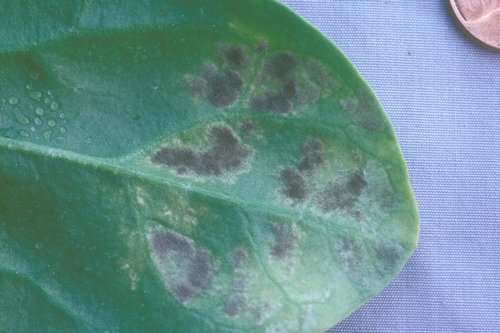Another new race, the 13th, of the downy mildew pathogen (Peronospora farinosa f. sp. spinaciae) of spinach has been found and documented. First identified in January 2010 from spinach in Holtville, California, this race breaks the resistance of several important cultivars. The isolate was initially designated as UA0510C and was characterized with a standard set of differential varieties. Isolates apparently identical to UA0510C have been found in an increasing number of locations throughout California in 2010 and 2011. After careful evaluation of the significance of this development to the spinach industry, the International Working Group on Peronospora (IWGP) has designated this isolate as race Pfs 13. The IWGP is located in The Netherlands and is administered by Plantum NL.
Race Pfs 13 poses a threat to the spinach industry because it is particularly well-adapted to modern hybrids with resistance to races 1-12. The appearance of a new race is not unexpected because hybrids with resistance to races 1-12 have been widely planted over the past few years. Similar developments have taken place when races Pfs 5 (1996), Pfs 6 (1998), Pfs 7 (1999), Pfs 8 and 10 (2004), Pfs 11 (2009), and Pfs 12 (2009) were identified and named. The occurrence of Pfs 13 will clearly encourage the industry to develop and use new spinach cultivars having resistance to races 1-13. A history of the detection of the various spinach downy mildew races is presented in Table 1.
A collaboration of researchers with the IWGP, University of Arkansas (Correll), and University of California (Koike) is monitoring the development of new races of spinach downy mildew on a global scale by collecting and testing suspected new isolates. In this way it is hoped that research findings and conclusions will be agreed upon and better communicated between the seed industry, spinach growers, and other interested parties. For California and Arizona, the Correll-Koike team will continue to receive and test spinach downy mildew samples for growers, pest control advisors, and seed companies. Industry is encouraged to continue to submit downy mildew outbreak samples to Correll-Koike, as such samples facilitate the discovery of additional new races. The Correll-Koike research is made possible by support from the California Leafy Greens Research Board and by active participation by the agricultural industries in California and Arizona.
For more information on this subject you can contact Steven Koike (stkoike@ucdavis.edu), Jim Correll (jcorrell@uark.edu), Diederik Smilde (d.smilde@naktuinbouw.nl), or IWGP chairperson Jan de Visser (JandeVisser@popvriendseeds.nl).
Table 1. Races of spinach downy mildew and year of detection
| Year | Race |
| 1824 | 1 |
| 1958 | 2 |
| 1976 | 3 |
| 1990 | 4 |
| 1996 | 5 |
| 1998 | 6 |
| 1999 | 7 |
| 2004 | 8 |
| ... | (9)* |
| 2004 | 10 |
| 2008 | 11 |
| 2009 | 12 |
| 2010 | 13 |
*One time detection only

Downy mildew of spinach is the most important disease on this crop and results in quality and yield losses.